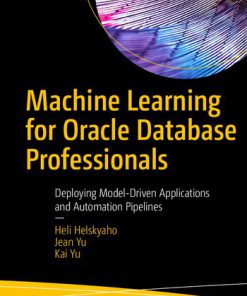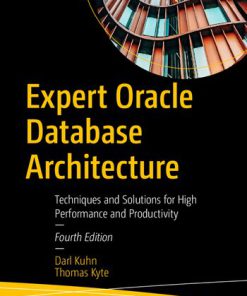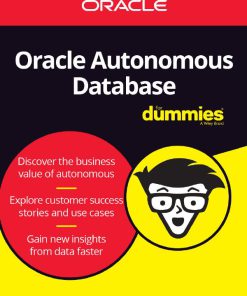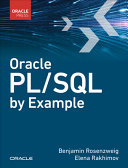Resilient Oracle PL SQL Building Resilient Database Solutions for Continuous Operation 1st Edition by Stephen Morris ISBN 9781098134112 1098134117
$50.00 Original price was: $50.00.$25.00Current price is: $25.00.
Resilient Oracle PL SQL Building Resilient Database Solutions for Continuous Operation 1st Edition by Stephen Morris – Ebook PDF Instant Download/Delivery: 9781098134112 ,1098134117
Full download Resilient Oracle PL SQL Building Resilient Database Solutions for Continuous Operation 1st Edition after payment
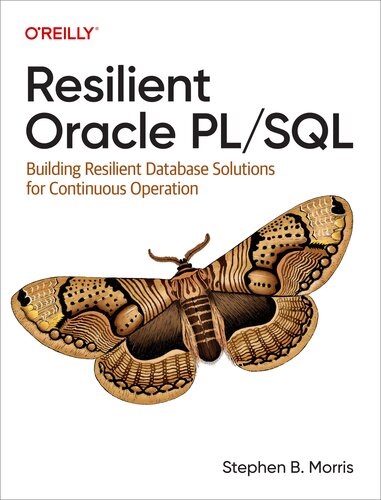
Product details:
ISBN 10: 1098134117
ISBN 13: 9781098134112
Author: Stephen Morris
Resilient Oracle PL SQL Building Resilient Database Solutions for Continuous Operation 1st Edition Table of contents:
I. Creating a PL/SQL Toolbox
1. Resilient Software and PL/SQL
Resilient Software
Examples of Resilient Systems
Requirements for Resilience: What Versus How
Motivation for Using PL/SQL: Don’t Cut a Pizza with a Wrench
Learning Java ORM
Complex Data-Centric Workflows
Using SQL for Complex Business Logic Is a Bad Idea
A Cautionary Tale
Embracing PL/SQL Abstractions
Disadvantages of PL/SQL
There Is a Better Way
Gaining a Basic Understanding of PL/SQL
How to Read Existing or Legacy PL/SQL Code
Cursors
Understanding the Need for a PL/SQL Learning and Development Environment
The Scale of Resilience
Capture All Errors and Exceptions: Score = 0
Recoverability: Score = 2
Observability: Score = 0
Modifiability: Score = 5
Modularity: Score = 2
Simplicity: Score = 5
Coding Conventions: Score = 5
Reusability: Score = 2
Repeatable Testing: Score = 2
Avoiding Common Antipatterns: Score = 0
Schema Evolution: Score = 0
Summary
2. Installation of a Containerized Oracle Database Instance and SQL Developer
A Virtualized Oracle Database Installation
Getting Started with Docker
Configuring Your Oracle Database
Updating the User Password
Getting Started with SQL Developer
Recap of the Basic Docker Workflow
Running SQL Developer
A Simple Schema
Running Some PL/SQL Code
Three Docker Gotchas
1. Docker Case-Sensitivity
2. Connecting to the Database Too Soon
3. A Docker Issue Caused by the Dreaded Windows Updates
An Alternative to the Command-Line Use of Docker
Another Alternative to the Command-Line Use of Docker
Summary
3. Taking SQL Developer for a Drive
Fixing the Pesky PL/SQL Error
Installing a PL/SQL Procedure in the Database
Installing the Stored Procedure in the Database
Executing the PL/SQL Procedure
The Takeaway: Errors Are Good Teachers
Summary
4. Applying the Scale of Resilience to the PL/SQL Code
Scale of Resilience Requirement 1: Capture All Errors and Exceptions
The Changes for Exception Handling
Running the Updated PL/SQL
Scale of Resilience Requirement 2: Recoverability
Scale of Resilience Requirement 3: Observability
What to Do If Logging Hits an Exception?
Updated Schema
Scale of Resilience Requirement 4: Modifiability
Scale of Resilience Requirement 5: Modularity
A Logging Package
Creating a Logging Package
Integrating the Logging Facility
Scale of Resilience Requirement 6: Simplicity
Scale of Resilience Requirement 7: Coding Conventions
Scale of Resilience Requirement 8: Reusability
Scale of Resilience Requirement 9: Repeatable Testing
Installing utPLSQL
Creating a utPLSQL Unit Test in SQL Developer
Running a utPLSQL Unit Test
Scale of Resilience Requirement 10: Avoiding Common Antipatterns
Code That Is Too Long
Overly Complex Code
Lack of Exception/Error Handling
Exceptions That You Decide to Live With
Lack of Modularity
Crashes with No Known Root Cause
Scale of Resilience Requirement 11: Schema Evolution
Scale of Resilience Change Summary
Summary
II. Feature-Driven Development
5. Calling PL/SQL
Two PL/SQL Integration Models
Calling PL/SQL Using a Job
Calling PL/SQL Using a Java Program
Setting Up a Simple Java Application
Running the Java Application
Who Owns the Java Error?
Reading Database Metadata
Some Java PL/SQL Gotchas
Oracle Database Password Gotcha
Summary
6. Introducing Feature-Driven PL/SQL Development
What Is a Feature?
A SQL Developer Feature
Examples of Features
Anatomy of a Feature
Articulating the Common Purpose of the Feature
Allowing the Definition of the Useful Work the Feature Can Do
Defining the Feature Helpers and Invocation Mechanism
Defining Tests to Exercise the Feature and Its Components
Identifying the Requirements for the Feature and Its Components
Reimagining the Log Procedure as a Feature
Considering the update_employees Procedure as a Feature
Testing Features or Vertical Slices
Business-Critical PL/SQL Code
Other Aspects of Features
Features and System Health
Features Versus Endpoints
Summary
III. Synthesis of the PL/SQL Toolbox and Feature-Driven Development
7. A Process-Centric, Feature-Based Mini Project
Requirement 1: Define the Requirements
Requirement 2: Build a Basic Invoice Outline
Requirement 3: Create a Schema
Requirement 4: Test the Schema
Requirement 5: Feature Description
Requirement 6: The PL/SQL Toolbox Elements Needed to Build a Solution
Requirement 7: Tests
Requirement 8: Building a Resilient PL/SQL Solution
Requirement 9: Verifying the Solution by Invoking It from a High-Level Language
Summary
8. From What to How: Building Feature Components from the Specification
The Requirements
Define the Requirements
Build a Basic Invoice Outline
Create the Schema
A PROJECTS Table
Test the Schema
Insert Some Data and Verify the Constraints
Verify That an Insert into the PROJECTS Table Works as Expected
Feature Workflow Description
Create a Project Invoice Data Set
Invoke the Feature from Java Code
Invoke the PL/SQL Procedure Passing the Required Data
Insert a Call to the New Invoice Creation PL/SQL Procedure
Run the Draft PL/SQL Code First in SQL Developer
Insert a Row in the INVOICES Table
Add Two Helpers
Performance Note: PL/SQL Versus SQL
Quick Project Status Report
Project Feature Status Report Revisited
Summary
9. Building the Complete Feature: Final Project Integration
Revisiting the Scale of Resilience
Revisiting the Schema with Reference to the Model
Back to Error and Exception Management
Resilience Requirements Checklist
Recoverability
Observability
Modifiability
Modularity
Tests
Build a Basic Invoice Creation Tool
Add Logging
Call the Logging PL/SQL Procedure from Java Code
Summary
10. Conclusion
Some Takeaways
Avoiding Egregious Antipatterns
Docker: A Technology to Learn Oracle Database
Errors as Teachers and Reading Code
Legacy Code and the Scale of Resilience
PL/SQL and High-Level Language Integration
Features as Coarse-Grained Placeholders
Summary
A. Troubleshooting a Native Oracle Installation
Installation Procedure
Container Versus Pluggable Databases
Table Structure
Is the Oracle Service Running?
B. Additional Options for Oracle Database Logging
The sys.dbms_system.ksdwrt Procedure
The dbms_adr and dbms_adr_app Packages
The Error Stack
Index
People also search for Resilient Oracle PL SQL Building Resilient Database Solutions for Continuous Operation 1st Edition:
resilient database design
resilient database
oracle resiliency
resilient oracle pl/sql
oracle resilience options
Tags: Stephen Morris, Resilient Oracle, PL SQL, Resilient Database, Continuous Operation
You may also like…
Computers - Artificial Intelligence (AI)
Machine Learning for Oracle Database Professionals 1st Edition Heli Helskyaho
Computers - Databases
Business & Economics - Management & Leadership
Computers - Programming
Engineering - Energy & Power Resources
Computers - Databases
Biology and other natural sciences - Plants: Agriculture and Forestry
Hobbies & Games - Training & Coaching



